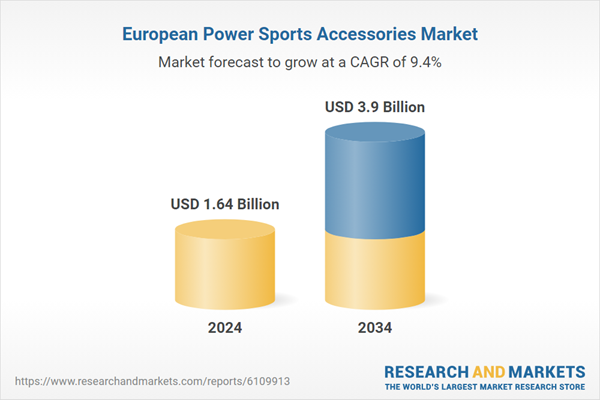Consumers today are not just looking for basic utility; they are demanding well-designed gear that also contributes to overall riding satisfaction. This shift in preference is fueling the development of cutting-edge accessories featuring lightweight materials and ergonomic design. Innovation is a central factor - products that incorporate smart features, durable construction, and aesthetic appeal are gaining considerable traction. Technological advancements are changing the way accessories are built and used, with intelligent safety gear gaining popularity. Wearables and connected equipment are adding a new dimension to riding by enhancing both protection and user experience. These innovations are aligning with a more informed and demanding customer base, leading to strong aftermarket demand.
The product landscape of the Europe power sports accessories market includes cab systems, protective gear, and apparel. In 2024, protective gear represented around 53% of the overall revenue share, and this segment is anticipated to grow at a CAGR exceeding 11% through 2034. Protective equipment has evolved from simple safeguards to technologically enabled gear that offers real-time safety support. Modern helmets, jackets, and gloves come embedded with features such as impact detection, location tracking, and wireless communication. These enhancements appeal to riders who prefer additional safety, especially when traveling alone or engaging in long-distance rides. The convenience of integrated functionality in safety gear is pushing buyers toward premium products, creating new opportunities for innovation and differentiation.
When viewed by vehicle type, the market is divided into ATVs, UTVs, snowmobiles, personal watercraft, and heavyweight motorcycles. In 2024, the heavyweight motorcycles segment held a 34% share of the market and is projected to grow at a CAGR of over 10% between 2025 and 2034. The growing popularity of touring and adventure motorcycles has increased the demand for accessory upgrades that improve the travel experience. Riders often invest in performance-enhancing add-ons, including navigation systems, enhanced wind protection, protective body components, and ergonomic seating. These purchases are tied to an evolving rider lifestyle focused on exploration, endurance, and comfort during long journeys, fueling a robust aftermarket economy in this segment.
Based on sales channel, the market is split between online and offline distribution. The offline segment dominated in 2024 and is expected to witness strong growth over the coming years. Physical retail stores provide riders with hands-on access to products, which remains critical in this market. The ability to try on and physically evaluate items such as helmets or jackets makes offline shopping more appealing. Retailers and brand-exclusive outlets also offer expert guidance and product guarantees, reinforcing customer confidence and loyalty. As more brands strengthen their dealership networks across Europe, offline channels are expected to maintain a substantial lead.
On the basis of end use, the market is categorized into individual and commercial users. In 2024, the individual segment accounted for the largest market share and is forecasted to grow steadily. Recreational use of power sports vehicles is increasing across Europe, with a surge in leisure-focused activities such as touring, off-road exploration, and weekend riding. This shift is contributing to the demand for customized and purpose-driven accessories that enhance personal comfort and travel readiness. Riders are actively investing in functional upgrades that include storage systems, hydration kits, and travel-oriented modifications, further driving the trend of personalization within the segment.
Regionally, Germany emerged as the leading market in 2024, holding 26% of the Europe revenue share and generating USD 432.7 million. A strong culture of motorcycle ownership and a large population of active riders position Germany as a major contributor to accessory demand. The mature user base shows a consistent appetite for high-quality accessories that improve performance, comfort, and safety.
In addition to traditional growth drivers, the shift toward electric mobility is reshaping the power sports accessories space. The rising adoption of electric two-wheelers, particularly among younger and environmentally conscious consumers, is pushing manufacturers to offer accessories tailored for EVs. This includes lightweight, energy-efficient gear and integrated digital solutions. As smart technologies like Bluetooth connectivity and GPS tracking become mainstream, manufacturers have an opportunity to align their offerings with changing user expectations. Regulatory support for sustainable mobility also plays a role in this evolution, opening the door for future-ready product development and broader market reach across the continent.
Comprehensive Market Analysis and Forecast
- Industry trends, key growth drivers, challenges, future opportunities, and regulatory landscape
- Competitive landscape with Porter’s Five Forces and PESTEL analysis
- Market size, segmentation, and regional forecasts
- In-depth company profiles, business strategies, financial insights, and SWOT analysis
This product will be delivered within 2-4 business days.
Table of Contents
Companies Mentioned
- ACERBIS Italia
- Alpinestars
- Arctic Cat Inc. (Textron Inc.)
- BMW Motorrad
- BRP Inc. (Bombardier Recreational Products)
- Fox Racing
- GIVI
- Harley-Davidson
- Honda Motor
- Kawasaki Heavy Industries
- KTM
- Leatt Corporation
- Polaris
- Puig Hi-Tech Parts
- Rukka (owned by L-Fashion Group)
- SCOTT Sports
- Suzuki Motor Corporation
- SW-Motech GmbH & Co.
- Touratech
- Yamaha Motor
Table Information
| Report Attribute | Details |
|---|---|
| No. of Pages | 190 |
| Published | June 2025 |
| Forecast Period | 2024 - 2034 |
| Estimated Market Value ( USD | $ 1.64 Billion |
| Forecasted Market Value ( USD | $ 3.9 Billion |
| Compound Annual Growth Rate | 9.4% |
| Regions Covered | Europe |
| No. of Companies Mentioned | 20 |









